SACRED LIVING MOVEMENT TIMELINE
1970: Anni Daulter was born.
2005: Anni Daulter founded Bohemian Baby.
2012 (May): Sacred Pregnancy: A Loving Guide and Journal for Expectant Moms was published.
2012 (November): The first Sacred Pregnancy retreat was held in California.
2015 (June): A campaign was initiated on the Go Fund Me crowd fundraising platform to raise money for a Retreat Center for the Sacred Living Movement.
2016 (July): Anni Daulter and Niki Dewart published Sacred Motherhood: An Inspirational Guide and Journal for Mindfully Mothering Children of All Ages.
2017 (January): Anni Daulter, Jessica Booth and Jessica Smithson published Sacred Medicine Cupboard: A Holistic Guide and Journal for Caring for Your Family Naturally.
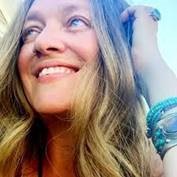
2017 (August): Anni Daulter published Sacred Pregnancy Journey Deck: Inspirational Guidance for Your Pregnancy
2017 (September): Anni and Tim Daulter published Sacred Relationship: Heart Work for Couples: Daily Practices and Inspirations for a Deeper Connection
FOUNDER/GROUP HISTORY
Anni Daulter was born in 1970. [Image at right] She attributes her early interest in storytelling to her mother, who she has described as unusually adept at making space for and encouraging others to tell their stories to her (Ramakrishna n.d.). She pursued her education at the University of Southern California and received a Masters Degree in Social Work.
Anni’s husband, Tim Daulter, earned a PhD in Chemical Engineering from the University of Delaware and in 2001 a MBA in Business Management from Pepperdine University. In addition to co-founding Sacred Relationship with Anni, 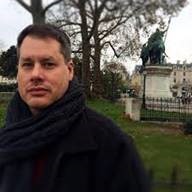 Tim is Founder of Sacred Men. [Image at right] The couple has had four children (Zoë, Lotus Sunshine, Bodhi Ocean and River Love).
Tim is Founder of Sacred Men. [Image at right] The couple has had four children (Zoë, Lotus Sunshine, Bodhi Ocean and River Love).
It was after the birth of their first child that Anni Daulter began a writing career, authoring four books on organic and healthy living lifestyles. She was founder and owner of Bohemian Baby, an organic baby food company, between 2005 and 2008. It was her fourth book, Sacred Pregnancy, published in 2012, that led her to shift her career emphasis and form the Sacred Living Movement with her husband.
As Anni Daulter describes, the Sacred Living Movement was born out of a need Daulter herself sensed as she negotiated the world of pregnancy, birth and early childhood as a young mother. Attending a prenatal yoga class, she noticed that the most meaningful experiences women enjoyed were the connections made around the water cooler or over tea after class. It was the connections, the story telling and community that women craved and that Daulter then strove to create. What began with a single Sacred Pregnancy Retreat in Ojai, California in November 2012 has grown to a movement that has held retreats in over ten countries and has trained hundreds of women to be instructors and practitioners in their own communities. While the movement began with small scale retreats focused primarily on pregnancy and birth, the movement has since grown to include retreats and trainings for rites of passage from girl’s first menstruation to breastfeeding to pregnancy loss, infertility, menopause and themes such as relationships, brotherhood, and financial success. In each of these retreats, the focus is to bring the sacred to the mundane and to infuse community into what has become individualized and isolated.
When Daulter talks about her hope for the movement and her motivations for creating it, she reflects on a return to primordial religion and to paradigms of the divine feminine, before patriarchy worked its way in, before society created barriers to religious and spiritual expression. In her retreats and communities, she hopes to create space where women (and occasionally men) can access the divine within them and connect with the sacred within themselves but also within the rites of passage in their own lives and in their connections to other women and men in their families and communities. She is not creating a new religion and does not seek exclusive commitment or a particular label. Her movement, her retreats, books, trainings are meant to help supplement, deepen, enrich whatever path people are already on just as they might chart a path for someone searching for a path anew.
DOCTRINES/BELIEFS
The Sacred Living Movement does not profess any institutional doctrines or beliefs that its members, attendees, leaders, must adhere to or affirm. Instead, the movement welcomes participants from any religious tradition and does not suggest nor require that any participants renounce or replace any of those religious doctrines with those of the movement. As such, the books, websites and other publications of the movement do not contain belief statements or membership guidelines. The Movement instead is meant to supplement, enrich, and enhance the religious and spiritual life of the participant, whether that fits within an institutional religious tradition or not. In interviews, Daulter describes how this works in practice. Recognizing that some of the particular rituals or practices of the movement might conflict with the doctrines or practices of an individual participant, she encourages people to change the words, the meanings, abstain or reorient as they desire. The emphasis is not on conformity to a doctrine or orthodoxy or orthopraxy but rather to a deepening of experience and a sense of the sacred for the individual. In order for that to be authentic and true, it might look different for each and every person.
With these caveats in mind, a general philosophy can be gleaned from the offerings of the Sacred Living University website, from the various books published by Anni Daulter and her co-authors, from the content of the trainings, and from descriptions of the retreats themselves. The term “sacred” infuses the entire movement and belies a sense that all aspects of the immanent realm, from the mundane tasks of everyday life to the very basic of bodily functions and abilities, have the potential to be carried out with elevated focus and reverence. To see the sacred in the mundane but also in the less mundane (the rites of passage that mark the lives of women, in particular) those rites of passage that have been, of late, medicalized, isolated, 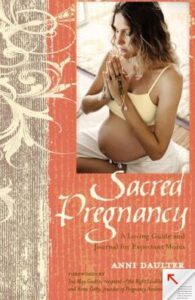 and made impersonal, is both a radical and transformative move in the eyes of the movement. To elevate not just pregnancy and birth but menstruation, breastfeeding, menopause, sexuality to the level of the sacred means to embrace the human, the divine feminine, and life in new and powerful ways. [Image at right] The rituals practiced at retreats and suggested in the books all help to infuse the reader or attendees life with these new sensibilities. To do these rituals in connection with other people, either in a community at a retreat or with the support of a trained practitioner, deepens the experience of connection as well.
and made impersonal, is both a radical and transformative move in the eyes of the movement. To elevate not just pregnancy and birth but menstruation, breastfeeding, menopause, sexuality to the level of the sacred means to embrace the human, the divine feminine, and life in new and powerful ways. [Image at right] The rituals practiced at retreats and suggested in the books all help to infuse the reader or attendees life with these new sensibilities. To do these rituals in connection with other people, either in a community at a retreat or with the support of a trained practitioner, deepens the experience of connection as well.
And it is this focus on infusing sacrality into life that is the most central belief of the movement. The wide spectrum of religions, spiritual and cultural traditions that influence the rituals and practices that the movement utilizes to achieve that goal demonstrate that the focus is on the goal more than on any commitment to orthodoxy or orthopraxy. The movement makes no attempt to define ultimate reality or even define the “sacred” but rather is a collective effort to elevate the human experience to greater connection, greater beauty and reverence. And it is this broad and intentionally vague language that makes the movement potentially accessible to a broad range of people. Participants range from devout practitioners of institutional religions that demand exclusive commitments but who are seeking something to supplement what they find in their religious community to the Spiritual but not Religious for whom this might be their only spiritual practice and community.
RITUALS/PRACTICES
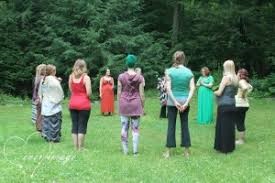
The Sacred Living Movement would have little meaning without ritual. Each of the retreats and trainings center around carefully designed rituals meant to build community, [Image at right] encourage reflection, and bring a sense of the sacred to the rite of passage. The rituals and practices of the Sacred Living Movement differ based upon the particular retreat and/or training but all borrow freely from a variety of traditions and cultures. Anni Daulter herself ascribes to a mix of Buddhist and Pagan traditions and has recently begun to integrate a variety of Wiccan traditions into the Movement’s offerings.
The rituals used are very much dependent on the focus of a particular training or retreat. For example, if a retreat or training is focused on a particular aspect of pregnancy, birth or postpartum care, the rituals will be a combination of emotional, spiritual, and physical focus. For a women taking part in a postpartum retreat, there might be opportunities for journaling and processing of the birth experience, recording of the story in a beautiful journal as a keepsake as well as sharing the story with other women for affirmation and community formation. Women might also take part in rituals that involve holistic care for the body, the use of herbal and traditional remedies to heal traumatized parts of the body as well as floral baths and tinctures to elevate the woman’s spirit and bring about a re-connection with her physical self. Rituals provide opportunities to recognize the power and beauty of the mother, encourage bonding with the baby, and care for and heal the body. Each ritual is performed with attention to the psychological effects of the dramatic and life-altering experience of giving birth and transitioning into motherhood, thus elevating even the most basic aspects of postpartum care to the level of spiritual ritual and sacred practice.
ORGANIZATION/LEADERSHIP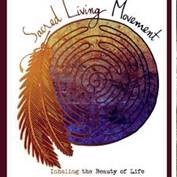
The Sacred Living Movement [Image at right] is now organized online under the title “Sacred Living University” as a means of emphasizing the use of retreats and online forum for training and community building. Anni Daulter is listed as the founder and creator and she is joined in the leadership team by her husband Tim Daulter and nine women. Each of these eleven individuals is connected to one, two, or three of the specific programs on offer. These individuals usually coordinate the specific trainings under their purview and lead in-person retreats when offered.
The movement now holds retreats throughout the world though its primary focus remains in the continental United States. Moreover, local groups often meet regularly, sometimes without direct connection to the national movement. The online presence of the movement has increased and now includes several avenues for training that enable trainees to use the skills and techniques gained to lead spiritual communities or to provide paid services to people in their communities. In recent years, the movement’s internet presence has evolved from advertising upcoming retreats to focusing on online trainings. Designed by Jessica Rose Booth, the website displays these offerings in the characteristic style of the movement.
What is now called “Sacred Living University” is a series of online trainings to enable individuals to gain training and certification in a variety of rituals and services that they might then offer to individuals and groups in their community. These trainings are grouped into three categories. The first, “Rites of Passage” focus on bringing “mindfulness, ceremony and beauty to life’s milestones & transitions” (Sacred Living University. n.d. “Rites of Passage”). These include Sacred Menarche, Sacred Blood Mysteries, Conscious Conception, Sacred Fertility, Sacred Mother Blessing, Sacred Pregnancy, Sacred Birth Journey, The Art of Sacred Postpartum, Sacred Belly Bind, Sacred Milk Tent, Sacred V Steams & Teas, and Sacred Menopause. In all cases, these classes are “grounded in heart work, and include practical skills, ceremony, intentional rituals and holistic wellness” (Sacred Living University n.d. “Rites of Passage”). The second category, “Intentional Living,” promises “approaches to life that help you thrive in all ways” but does not yet have any classes listed (Sacred Living University n.d. “Online Classes”). The third category of classes is “Touching Your Magic.” The track has two pathways: “Claiming Your Power” classes, which “focus on claiming your strength, your unfolding truths and your potent visions” and “Practical Magic” Classes, which offer guidance on specific daily practice of magic (Sacred Living University. n.d. “Touching Your Magic”). Among the offerings for “Claiming Your Power” are “I Am Sisterhood, Priestess Path and Sacred Brotherhood. For “Practical Magic,” they offer Intro to Spell Craft, Potions, Rebel Rose Reiki, Sacred Crystals, Sacred Elements, Sacred Money Manifestation, Sacred Ritual Dance, Sacred Ritual Dream, Sacred Sex Magick, Sacred Goddess Red Drum, Sacred Cacao Ceremony and Sacred Year.
As Daulter describes it, the movement has grown organically as the need for new and different retreats and trainings has arisen. Different members of the organization have been tapped to take on the leadership of these new initiative based on their expertise. The women and few men who now oversee particular aspects of the movement have expertise in those areas and thus have authority to develop the particular curriculum for trainings and agenda for retreats. All areas of the movement operate within the general philosophy of the movement, and all are influenced by the “beauty way” that Daulter infuses throughout the movement.
Though not listed anywhere formally on the Sacred Living Movement’s website, there exist a number of local affiliates of the movement that offer local retreats and community connections that build on the philosophy and model of the Sacred Living Movement. Often started by women who have attended Sacred Living Movement retreats and participated in trainings, these local affiliates have varying levels of conformity to the national movement and go by a variety of names.
ISSUES/CHALLENGES
The challenges facing the Sacred Living Movement are those shared by many similar movements that are loosely organized, relatively new, and geographically dispersed. Some of these challenges have also enabled the movement to pivot and grow in ways that are difficult for more established and institutionalized religious organizations and has also allowed the movement to continue its work in the midst of the Covid-19 pandemic of 2020-2021.
One challenge to movement integration is that the Sacred Living Movement does not have a central location and so any community gatherings that happen would be in varied locals or even only in cyberspace. The movement did undertake a fundraising campaign to raise money for a central retreat center (Crowder n.d.). This does not seem to have come to fruition. While the fundraising effort was begun in June of 2015 with a goal of raising $300,000 to establish a space for live retreats and a tiny house village for year-round living, the site has currently raised less than $5,000 and does not appear to be active. The last donation was made fifty-six months prior to this writing. Interestingly, the virtual focus of the movement and the transitory nature of the retreats has made the movement able to weather the financial strains of the Covid-19 pandemic in ways that other more geographically-fixed movements have not. While other movements have had to learn how to create community online or to complete instruction and trainings through the internet, this was already the model on which this movement operates.
A second challenge is the movement’s cultural appropriation of ideas and practices. A spiritual movement without ties to a particular religious tradition, the Sacred Living Movement frequently adapts and applies practices and ideas from a variety of religious and spiritual traditions as well as cultures from throughout the world. While attribution is sometimes given in the books that spell out particular rituals or in training manuals and materials, this is not always the case in the midst of a retreat or community gathering. This issue of potential cultural appropriation has brought some conflict or tension between the national and local movements. A predominantly white leadership and difficulty in diversifying participation in retreats and trainings have exacerbated these tensions. Local affiliates have been able to tailor their activities to cast a wider net and potentially to offer a more palatable experience to a broader cross-section of women.
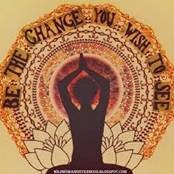
The Sacred Living Movement is still in its organizational infancy and has evolved and changed substantially over its short history. It clearly has resonated, primarily with women, who are seeking to connect with the divine feminine they understand to reside within them. [Image at right] It has adopted easily to online presence. At the same time, though Anni Daulter provides strong creative leadership to the movement, the movement does not possess a number of the integrative mechanisms commonly found in emerging spiritual and religious movements: a clear set of doctrines and practices that define movement identity and boundaries, mechanisms for producing membership growth and a successor generation, and a geographic base. Though such challenges might affect the continued success and growth of the movement, its focus on sacralizing and elevating rites of passage and bringing the sacred to pregnancy and birth in particular, are likely to continue to have significant cultural relevance for years to come.
IMAGES
Image #1: Anni Daulter.
Image #2: Tim Daulter
Image #3: The cover of Sacred Pregnancy: A Loving Guide and Journal for Expectant Moms by Anni Daulter.
Image #4: Sacred Living Movement ritual gathering.
Image #5: Sacred Living Movement logo.
Image #6: Sacred Living Movement symbolism.
REFERENCES**
** Unless otherwise noted, the material in this profile is drawn from Ann Duncan.
“Sacred Pregnancy in the Age of the ‘Nones’.” Journal of the American Academy of Religion 85:4 (December 2017): 1089-1115.
Crowder, Sue. n.d. “Sacred Living Center.” Gofundme. Accessed from https://www.gofundme.com/f/sacredlivingcenter on 15 January 2021.
Duncan, Ann. 2017. “Sacred Pregnancy in the Age of the ‘Nones,.” Journal of the American Academy of Religion 85:1089-1115.
Ramakrishna, Asha D. n.d. “Claiming Sacred Witch in Modern Times with Anni Daulter.” Women on Purpose. Accessed from https://soundcloud.com/ashaisnow/claiming-sacred-witch-in on 15 January 2021.
Sacred Living University. n.d. “Online Classes.” Accessed from http://www.sacredlivinguniversity.com/classes.html on 15 January 2021.
Sacred Living University. n.d. “Rites of Passage.” Accessed from http://www.sacredlivinguniversity.com/rites-744908.html on 15 January 2021.
Sacred Living University. n.d. “Touching Your Magic.” Accessed from http://www.sacredlivinguniversity.com/magic-467514.html on 15 January 2021.
SUPPLEMENTARY RESOURCES
Blumberg, Antonia. 2014. “A Woman’s Quest to Reinvigorate the Sacred Nature of Pregnancy,” HuffPost Religion, November 5. Accessed from http://www.huffingtonpost.com/entry/sacred-pregnancy-anni-daulter_us_563be540e4b0b24aee49af97 on 23 April 2020.
Daulter, Anni. 2017. Sacred Pregnancy Journey Deck: Inspirational Guidance for Your Pregnancy. Berkeley, CA: North Atlantic Books.
Daulter, Anni. 2012. Sacred Pregnancy: A Loving Guide and Journal for Expectant Moms. Berkeley, CA: North Atlantic Books.
Daulter, Anni. n.d. “Sacred Manifesto.” Sacred Pregnancy: The Deep Drink. Accessed from https://www.sacred-pregnancy.com/about-us on 20 April 2020.
Daulter, Anni, Jessica Booth and Jessica Smithson. 2017. Sacred Medicine Cupboard: A Holistic Guide and Journal for Caring for Your Family Naturally. Berkeley, CA: North Atlantic Books.
Daulter, Anni and Niki Dewart. 2016. Sacred Motherhood: An Inspirational Guide and Journal for Mindfully Mothering Children of All Ages. Berkeley, CA: North Atlantic Books.
Daulter, Anni and Tim Daulter. 2017. Sacred Relationship: Heart Work for Couples – Daily Practices and Inspirations for a Deeper Connection. Berkeley, CA: North Atlantic Books.
Publication Date:
29 January 2021
